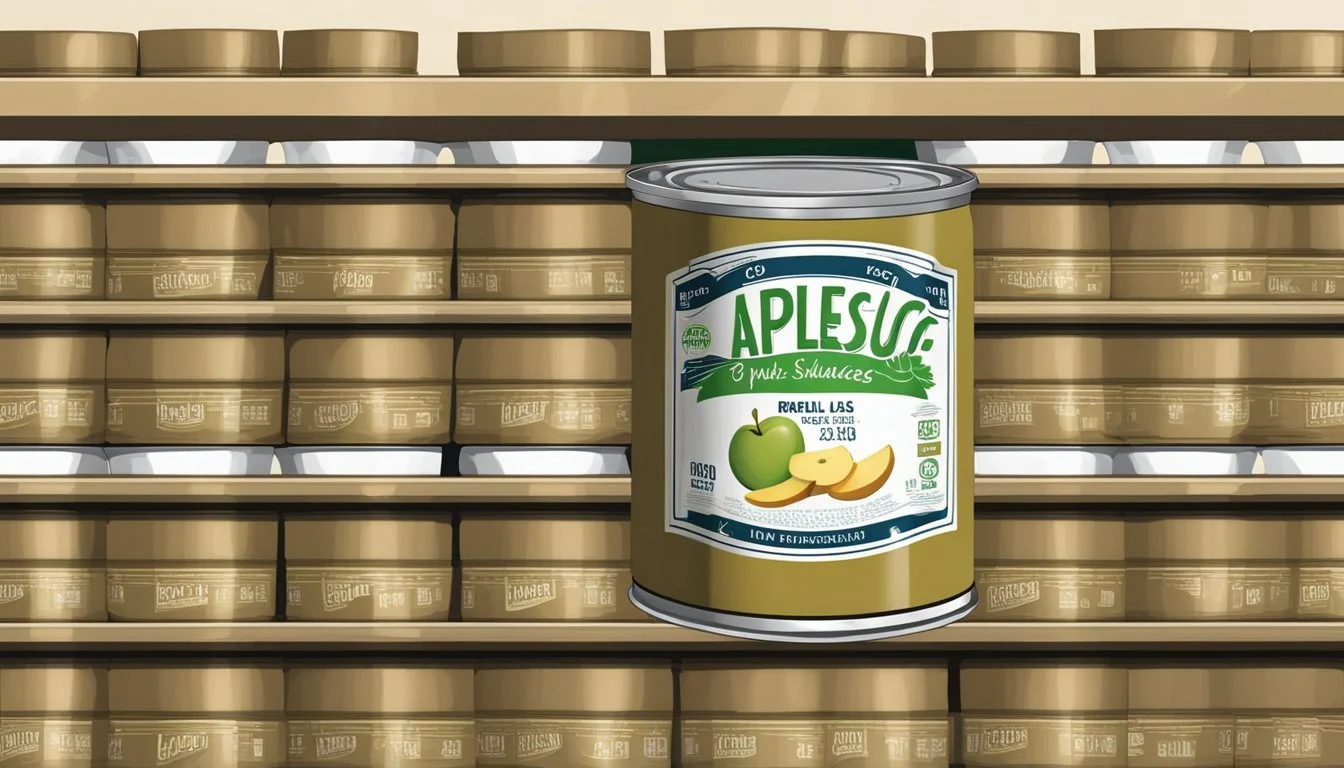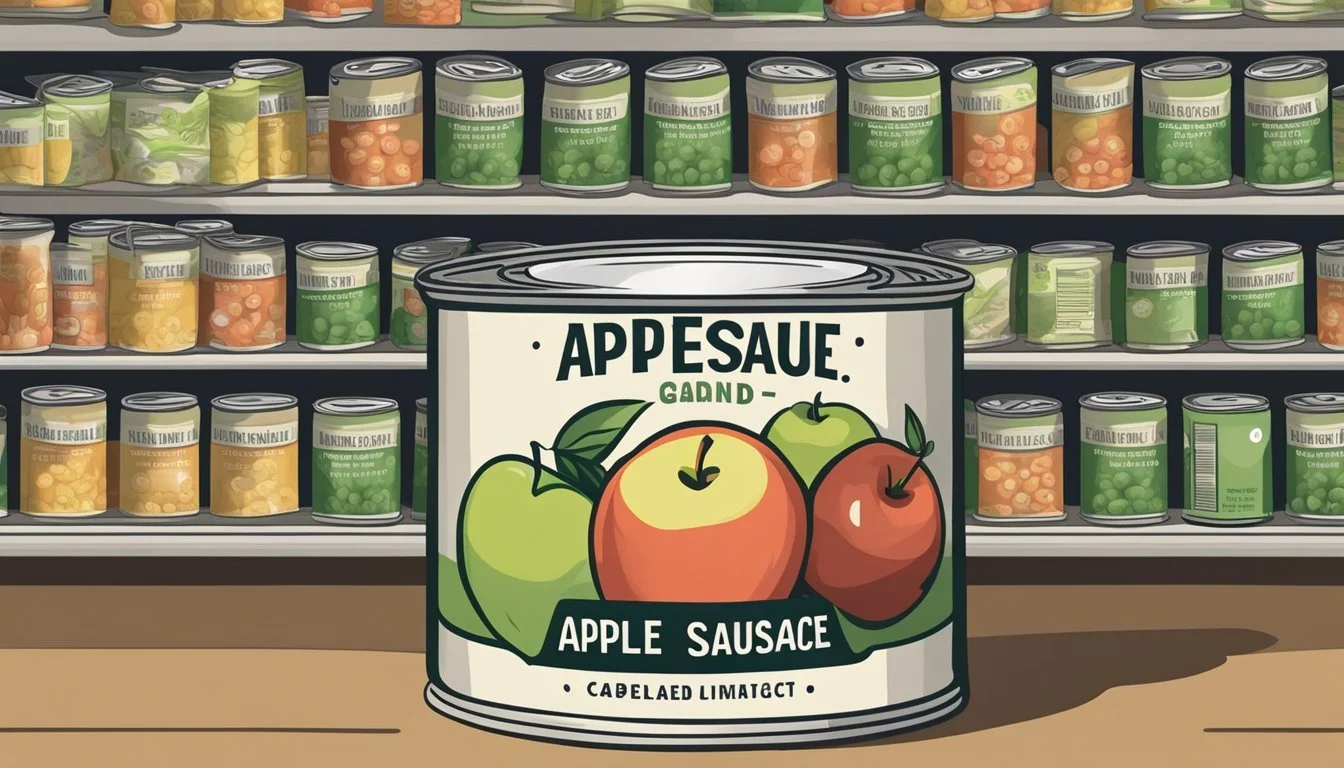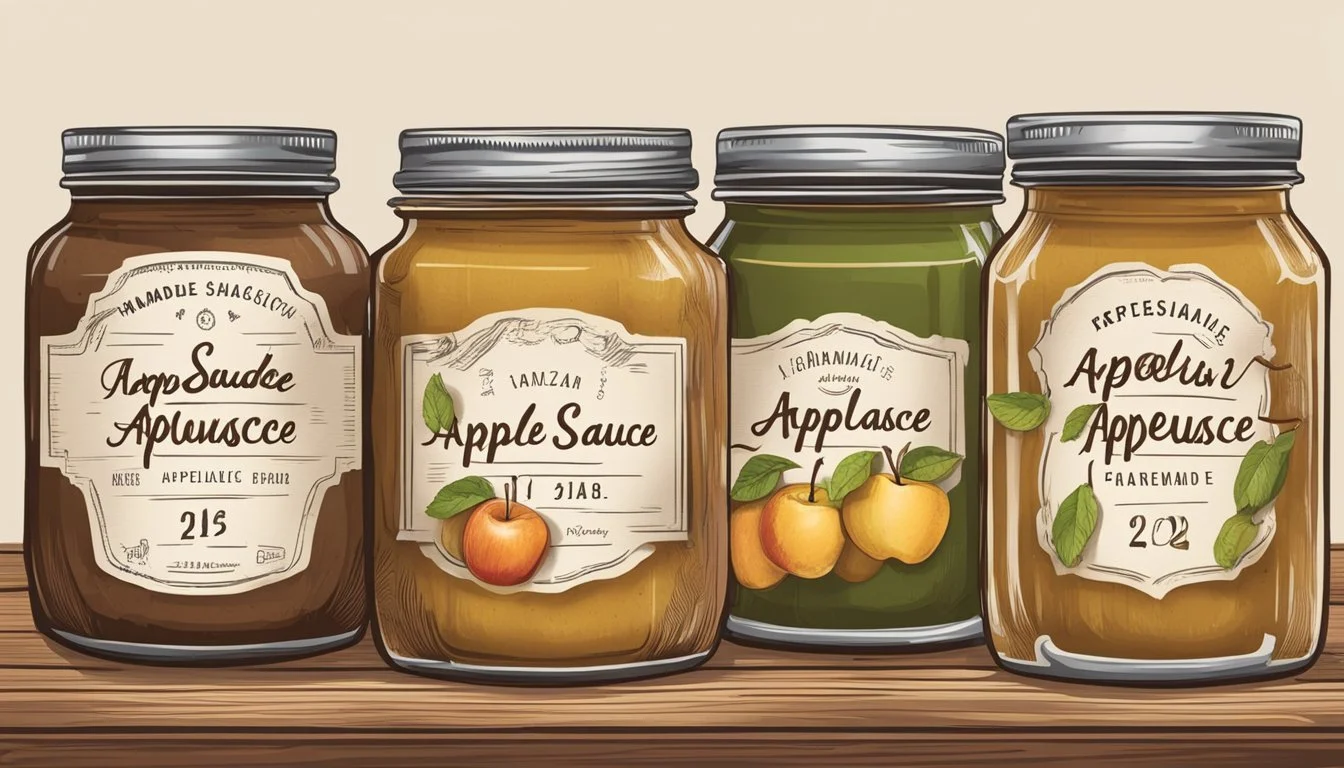How Long Does Canned Applesauce Last?
Shelf Life and Storage Insights
Canned applesauce is a popular pantry staple praised for its convenience and long shelf life. The preservation process maintains the quality of the applesauce, keeping it edible and flavorful for an extended period. Commercially canned applesauce typically retains optimal quality for 12 to 18 months when stored in a cool, dry place. Beyond this period, while it may still be safe to consume if unopened and free of spoilage signs, the applesauce may experience a decline in taste and vitamin content.
In the case of homemade applesauce, careful canning practices are critical to ensuring safety and longevity. When properly canned and stored, homemade applesauce can last for up to 12 months with peak quality. It's advisable to consume it within this time frame, although the applesauce can still be safe to eat beyond a year if the can remains sealed and uncompromised. Storage conditions play a significant role in the shelf life of both commercial and homemade canned applesauce; a stable environment away from light and significant temperature changes helps maintain its shelf life.
Understanding Applesauce
Applesauce is a versatile condiment created by cooking down apples. It can range from smooth to chunky and varies in flavor from sweet to tart, often enhanced by additional ingredients such as spices or sweeteners.
Types of Applesauce
When classified by texture, applesauce typically falls into two categories:
Smooth Applesauce: Pureed apples are evenly blended to create a consistent, creamy texture.
Chunky Applesauce: This type includes larger pieces of apple, giving it a more robust and varied texture.
Regarding preparation style and preservation, applesauce can be:
Commercially Canned Applesauce: Often pasteurized for shelf stability and available in various flavors.
Home-Canned Applesauce: Usually made in small batches and stored properly, it can retain quality for a year, recommended to be consumed within two years.
Key Ingredients
The primary ingredient in applesauce is, of course, apples. The choice of apple variety can significantly influence the taste; tart varieties result in a sharper flavor, while sweeter ones produce a milder sauce. Essential ingredients typically include:
Water: Necessary to cook the apples down and adjust consistency.
Sugar: Added for sweetness, the quantity can vary based on the natural sweetness of the apples used.
Lemon Juice: Often included to balance sweetness and prevent oxidation.
Optional ingredients to enhance flavor may comprise:
Cinnamon or Other Spices: Commonly used to add warmth and complexity.
Sweeteners: Beyond sugar, options like honey or syrup can be used for varied flavor profiles.
Canning Process for Applesauce
Applesauce can be a rewarding preserve to make at home, with the canning process ensuring it stays preserved for future enjoyment. Attention to detail in preparation, techniques, and sealing can determine the shelf-life and quality of the final product.
Preparation of Apples
The first step in canning applesauce is to prepare the apples. Choose fresh, ripe apples that are free from blemishes, and follow these steps:
Wash the apples thoroughly to remove any dirt or debris.
Peel the apples, as the skin can affect the texture and clarity of the sauce.
Core and cut the apples into chunks. Smaller pieces cook down faster and more evenly.
Simmer the apple pieces in a large pot with a little water until they become soft.
Purée the cooked apples using a food mill or an immersion blender to achieve the desired consistency—smooth or chunky.
Canning Techniques
Once the applesauce is prepared, canning is the next step to make the product shelf-stable. Utilize the following guidelines:
Heat the sauce until it is boiling.
Ladle the hot sauce into sterilized jars, taking care to leave the recommended 1/2-inch headspace. Headspace is vital to create a vacuum seal during cooling.
Remove air bubbles by running a non-metallic utensil around the inside of the jar.
Clean the jar rims with a damp cloth to ensure a clean seal.
Fingertip-tighten the lids to enable air to escape during the water bath process.
For the actual canning, you can use:
A water bath canner, which is suitable for high-acid foods like applesauce. Follow the manufacturer’s directions for processing time based on your altitude and jar size.
Pressure canning, which is an alternative method that typically is used for low-acid foods.
Sealing and Storing Canned Jars
After processing the jars:
Leave the jars in the canner for 10-15 minutes to cool down gradually and help reduce liquid loss from the jars.
Remove the jars and let them cool for 24 hours on a towel or cooling rack. Do not retighten bands during this time as it can disrupt the seal.
Check seals after 24 hours. Lids should not flex up and down when the center is pressed.
Label the jars with the content and canning date before storing them.
Store the sealed jars in a cool, dark pantry for optimal shelf life. Unsealed jars should be refrigerated and consumed relatively quickly.
Shelf Life and Storage
The longevity of canned applesauce greatly depends on whether the can remains sealed or has been opened. Proper storage conditions extend its shelf life, while maintaining its quality and safety.
Unopened Canned Applesauce
Shelf Life: Unopened canned applesauce typically lasts for 1-2 years past the production date if kept in ideal conditions.
Storage: To ensure maximum shelf life, one should store canned applesauce in a cool, dry place away from direct sunlight. The pantry or a cupboard away from heat is ideal. The cans should remain at room temperature.
Opened Canned Applesauce
Shelf Life: Once opened, applesauce should be consumed within 7-10 days.
Storage: After opening, refrigeration is necessary to maintain the safety and quality of the applesauce. It should be kept in an airtight container to preserve its texture and prevent contamination.
Freezing and Preserving Applesauce
Preserving applesauce through freezing is a practical and simple method. It enables long-term storage without compromising the quality of the applesauce if done correctly.
Freezing Techniques
To freeze applesauce effectively, one should ensure that the applesauce is cooled completely after cooking. Use freezer bags or airtight containers to divide the applesauce into desired portions. This not only facilitates easy freezing but also makes thawing more convenient. It's crucial to leave a small amount of space at the top to allow for expansion as the applesauce freezes.
Label and Date: Clearly mark each container or bag with the freezing date.
Portion Control: Use measurements on the bag or container to freeze in specific portion sizes, if desired.
Sealing: Remove as much air as possible before sealing to prevent freezer burn.
Thawing After Freezing
Proper thawing of applesauce is essential to maintain its texture and flavor. To thaw frozen applesauce, transferring the container from the freezer to the refrigerator is the safest method, as it allows gradual defrosting. If a quicker method is needed, placing the container in a bowl of cold water can speed up the process. Never thaw applesauce at room temperature as it can lead to bacterial growth.
Refrigerator Method: Thaw overnight in the fridge.
Cold Water Method: Submerge in cold water, changing water every 30 minutes.
Post-Thaw: Once thawed, stir the applesauce to redistribute any separated water.
Following these steps ensures that frozen applesauce retains its flavor and consistency, providing a homemade taste even after months of preservation.
Safety and Spoilage
When assessing the safety and longevity of canned applesauce, it is important to recognize signs of spoilage and understand contamination prevention. A jar's contents may appear safe, but spoilage and harmful bacteria such as botulism can lurk without obvious indicators.
Identifying Spoiled Applesauce
Spoiled applesauce generally presents certain telltale signs that one should not ignore:
Odor: A sour or off-putting smell is a clear indicator that the applesauce has gone bad.
Mold: Visible mold growth, which can appear in various colors, indicates spoilage.
Color: Any discoloration can suggest contamination and should not be consumed.
Texture: A change in texture, such as excessive watery separation or mushiness, can signal spoilage.
Applesauce cans showing signs of rust or damage may also compromise the safety of the product inside.
Preventing Contamination
To avoid spoilage and ensure safety, certain practices should be followed:
Proper Sealing: Ensure that the container is airtight. This prevents the entry of bacteria which can cause spoilage.
Sanitary Equipment: Utilize sterilized utensils when handling applesauce to limit contamination.
Temperature Control: Store canned applesauce in a cool, dry place. If opened, refrigerate promptly.
The risk of botulism in commercially canned goods is very low due to rigorous safety standards but may increase in home-canned products if not processed correctly.
Homemade Applesauce Variations
Homemade applesauce offers a canvas for a multitude of flavors and textures, allowing one to tailor the condiment to personal tastes. Whether adding natural sweeteners like honey or adjusting the consistency to be perfectly smooth or chunky, making applesauce at home can be a delightful culinary experience.
Sweet and Flavorful Twists
When making homemade applesauce, the sweet and flavor profile can be enhanced with various ingredients. Honey serves as a natural sweetener that not only adds sweetness but also a distinct flavor. To infuse additional warmth and complexity, cinnamon and other spices like nutmeg or allspice can be incorporated. A squeeze of lemon juice introduces a bright note, balancing the sweetness with a hint of tartness. Here are specific ways to add flavor:
Honey: Stir in to taste after the apples are cooked and pureed.
Cinnamon: Add one teaspoon per four cups of apples for a classic touch.
Spices: Experiment with a pinch of nutmeg or allspice for deeper flavors.
Lemon juice: Add during cooking to preserve the apples' color and enhance flavor.
Texture and Consistency
The texture of homemade applesauce can be personalized from smooth to chunky. For a smooth texture, apples should be cooked thoroughly and then pureed using a blender or food processor. To achieve a chunky consistency, one can manually mash the apples with a potato masher to the desired level of chunkiness or only partially blend the mixture. The amount of water added during cooking also influences the final consistency – less water results in a thicker sauce, while more water creates a lighter texture. Here is a simple guide for adjusting textures:
Smooth Applesauce: Blend cooked apples until no lumps remain.
Chunky Applesauce: Mash cooked apples with a potato masher, leaving some chunks intact.
Water Adjustment: Start with minimal water and add as needed for desired thickness.
Practical Tips for Usage
When using canned applesauce, one should be mindful of its versatility in both cooking applications and as a direct food product. Knowing how to integrate it into meals and understand its preservation timeline can enhance the dining experience.
Cooking with Applesauce
Applesauce can serve as a substitute for certain ingredients in cooking and baking due to its consistency and natural sweetness. It can replace oil or butter in a 1:1 ratio, which not only reduces fat content but also retains moisture in recipes such as muffins or cakes. When cooking for smaller-sized batches, applesauce can make it easier to scale down recipes without affecting the texture of the final product.
Consuming Applesauce
For eating, one should consume home-canned applesauce within two years for optimal quality, although it remains safe beyond that period. It's best enjoyed chilled or at room temperature, and can be a delightful snack or a complement to dishes such as pork chops or potato pancakes. When one decides to enjoy applesauce, they may consider adding a dash of cinnamon or nutmeg to enhance its flavor.
Additional Considerations
When canning applesauce, certain variables can affect the shelf life and quality of the final product. Two critical factors to consider are the adjustment for altitude during the canning process and the selection of the right apples for canning.
Adjusting for Altitude
High altitudes can influence the processing time of canned applesauce due to changes in atmospheric pressure. For altitudes above 1,000 feet, it is necessary to increase the processing time or pressure to ensure the preservation of the applesauce. Instructions for altitude adjustments are usually provided with canning recipes or can be found in recognized canning guidelines.
1,001 - 3,000 feet: Add 5 minutes to the processing time.
3,001 - 6,000 feet: Add 10 minutes to the processing time.
Above 6,000 feet: Add 15 minutes to the processing time.
Selecting the Right Apples
The variety and type of apple selected can greatly impact the flavor, texture, and longevity of canned applesauce. Choose apples that are firm, ripe, and free of bruising to ensure a high-quality product.
Types of apples and their characteristics for canning:
Tart apples (Granny Smith, Jonathan): Provide a sharper flavor, good for a more vibrant applesauce.
Sweet apples (Fuji, Gala): Offer a naturally sweeter sauce, potentially reducing the need for added sugar.
Combination: Using a mix of apple types can create a balanced and complex flavor profile.
Before canning, apples should be properly peeled and cored to avoid unwanted textures and to ensure a smooth consistency in the applesauce.
Conclusion
When it comes to preserving applesauce, both commercial and homemade varieties have a decent shelf life. For canned applesauce, the typical high quality store period ranges from 12-18 months, although safe consumption can extend beyond this if the cans remain sealed and undamaged. Homemade applesauce, if preserved correctly, maintains its peak quality for about one year and is ideally consumed within two years.
Families making applesauce can enjoy their efforts for an extended time by following proper canning procedures. Once opened, any variety of applesauce is best if eaten within a week, and it should always be kept refrigerated during this time. For those who prepare in bulk, freezing applesauce extends its life up to one year, with airtight containers or freezer bags recommended to preserve quality.
In summary:
Canned Applesauce: Best used within 12-18 months, safe beyond if unopened.
Homemade Applesauce: Optimal for one year, recommended to use within two years.
After Opening:
Refrigerate and use within one week.
Freeze to extend shelf life to about a year.
Proper storage methods are key to preserve the integrity of applesauce, allowing one to store the product safely for future enjoyment. This helps ensure that the applesauce remains a delicious and safe addition to meals and snacks for both individuals and their families long after the applesauce has been made.








